|
Chapter XVI
The year after Oona left, we had a frightening
experience involving Jimmy Delaney who was living with Agnes in The Old
House. Our last days on the Herbertsville Road in West Point Pleasant
were right after a night when Jimmy, drunk and angry, came roaring over
from next door. He broke the glass in our front door, threatening Nanna.
He and Nanna had had an argument earlier in the day. (To this day I do
not know what it was about.) I was asleep in bed and a scream from my
mother woke me up. I ran downstairs to see what had happened. Mother
wasn’t there and I thought she had been killed.
Nanna stood on the porch, in the midst of all the broken glass, with
blood on her dress. Jimmy had gone. It was a nightmare for a
twelve-year-old. Our family was very quiet and reserved, and things like
this happened only in bad movies.
Nanna quieted me and said she cut herself picking up pieces of glass and
Budgie had gone next door to phone the police.
“Run upstairs and tell Robert everything is o.k.” Nanna sounded
shattered.
I found my little brother sitting up in bed, crying and frightened. I
told him everyone was all right. Mother came up to be with him and
anxiously asked me to run up the road and see if Homer would come down
and help us. Homer and Gerda lived three blocks up the road, and as well
as being dear friends, Gerda had been giving me piano lessons. My
emotions were on hold as I left Mother consoling Robert and Nanna
clearing up the glass downstairs. I ran very fast up the dark road which
seemed miles long.
“What are you doing here so late in the evening?” Homer asked as he
opened the door to me. I couldn’t speak. He leaned down to hold me, and
it was like a dam bursting. Totally shaken, I tried to explain, but the
words wouldn’t come out. I was in shock and both those dear people
comforted me until I could explain. “Please go down and help them! Jimmy
broke our door and they need you to help!”
Homer drove his car down, gathered up the family, and we stayed with
them overnight. I lay in bed on the porch with my grandmother, still
terrified and unable to sleep. That awful scene ran over and over in my
head for the rest of the night. If Aggie and Oona had been home this
would not have happened.
The next day we moved into a rooming house until we were able to move
into a house Mother found across the river in Brielle. We never went
back to the yellow ochre house again. I was glad to be gone from there
because I missed Oona so much, and it was easier to deal with this
hurtful loss in new surroundings.
My brother told me years later that he kept track of Jimmy whenever he
was around because he wanted to protect the family from anything like
that frightening night happening again.
During my first two years in high school, Oona was busy being a
debutante and enjoying the New York scene with her mother and brother.
The Second World War was still raging, and the U.S. had become involved.
It was a strange and difficult time. We were fingerprinted at school and
made to go through drills in case of war emergency, probably because of
living by the coast. Many of our older teachers left to go into the
service or take factory jobs and were replaced by new, younger teachers.
Friends in school were losing fathers or brothers in the overseas
fighting.
Oona and I were not in touch those two years, but I read the New York
papers and
kept up with what she was doing. She joined Shane at the Art Students
League in the city for a short time, but decided it was not for her.
Gene and Agnes wanted her to go
to college, but she refused. Shane continued studies at the League, and
became an accomplished sculptor. My brother and I remember the handsome
horses he sculpted later on in Point Pleasant.
Oona began moving in cafe society, taking part in war work, and I began
collecting news clippings. One page from the press showed Oona at the
Stage Door Canteen for servicemen. Another described her activities when
she was photographed as Debutante of the Year at a Russian War Relief
benefit, held at the Lafayette Hotel in Greenwich Village. The picture
was nationally syndicated. But my favorite ones were from The Sunday
Star-Ledger “Parade” section.
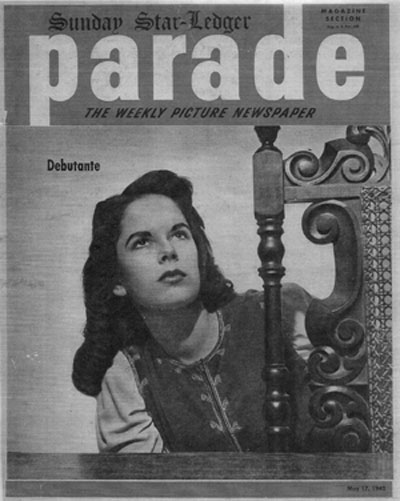 |
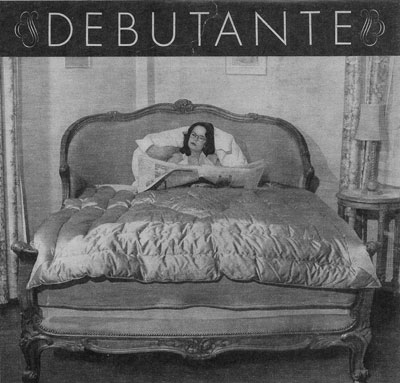 |
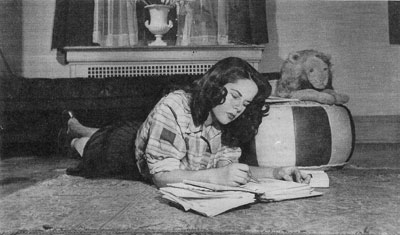 |
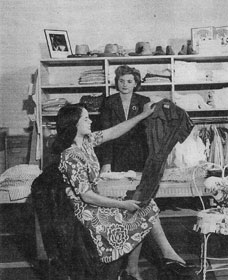 |
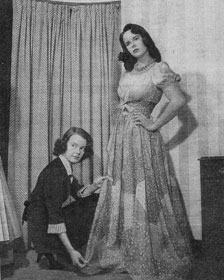 |
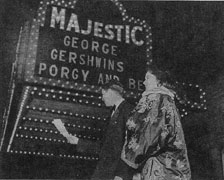 |
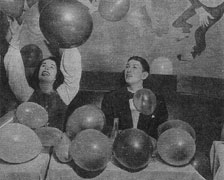 |
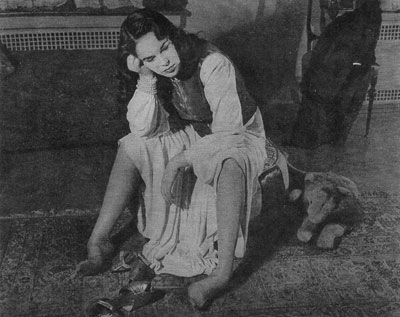 |
|
Four page “Parade” story of Oona's debutante days in 1942. |
Then came the magazine ad where Oona had been photographed for Pond’s
face cream. Budgie told me how angry Gene O’Neill was over this; he
thought it was cheap and beneath her. Perhaps, but she was busy in the
war effort and from my fifteen-year-old perspective, doing all kinds of
good and interesting things. Her mother also was very supportive.
Oona was in another world...and so very beautiful! I had heard she
wanted to go into theater and become an actress. She tried out and was
accepted for a part in the stage play of Pal Joey, to be held in the
Maplewood Theatre in New Jersey. The play was a failure, and Oona went
to Hollywood with her friend Carol Marcus. Aggie went there shortly
afterwards to do some screen writing.
Oona stayed in California, which again seemed so far away. After her
eighteenth birthday she signed up for a part in The Girl From Leningrad.
Her trial part as the lead was not successful. Next thing I heard, she
was to marry Charlie Chaplin!
The marriage of Oona O’Neill and Charles Chaplin made headlines in every
paper across the country. The big story was the thirty-six year age
difference. She was just eighteen and he was fifty-four. I didn’t care.
I just wished the reporters would leave her alone, and if they were
happy, what difference could it make? At sixteen, I was a romantic and
it all seemed quite exciting! My cousin Oona marrying Charlie Chaplin! I
laughed when I thought of our rollerskating and imitating Charlie in
Modern Times.
Suddenly I began hearing from Oona again about Charlie and her new
life. It was thrilling for me and the letters flew back and forth. Next
thing I knew she was coming back to New York. Oh, how I wanted to see
her.
Oona called to arrange a meeting in New York, and I was off on the bus.
I found their apartment and met Charlie, who entertained me while Oona
prepared herself for our lunch in town. Charlie described a recent
evening with some very comical character who had performed a song and
dance for them in a local club. He grabbed the cover from his breakfast
plate and donned it as a hat, proceeding to dance around the room. I was
a delighted audience!
Our lunch was at Club Twenty One. It was most impressive to a
sixteen-year-old girl from a small town in Connecticut. I had my first
vichyssoise and enjoyed watching the waiter wander around with a
bun-oven hanging over his shoulders, offering guests assorted hot
biscuits and pastries.
We talked about all the things that had happened since we had last seen
each other. Oona had much to tell. The most fascinating story was about
the F.B.I. having gone into her apartment in Hollywood just before her
marriage to Chaplin. The two F.B.I. agents made Oona sit in a chair
while they searched through bureaus, closets and boxes to see if they
could find anything that might incriminate Charlie. The F.B.I. had been
trying to find some reason to deport him. Aggie confirmed this and added
a rather bizarre tale involving William Randolph Hearst, the newspaper
king and owner of many big newspapers in the country.
The story went that Hearst was jealous of Chaplin, who had at one time
carried on with Hearst’s sweetheart and mistress, Marion Davies. Davies
was a showgirl turned actress, and Hearst lived with her in his Castle
at San Simeon, California, while his wife lived in New York. Hearst
engaged in such a tirade against Chaplin, with false claims about
the Joan Barry paternity case and trumped up stories of Charlie’s being
a communist, that the F.B.I. began to look into his private life. Hearst had
the reputation of being able to destroy anyone he did not like.
Charlie later told Aggie about almost being shot by Hearst, and Aggie
told the story to me. It seemed that Davies and Hearst gave a grand
party on their luxury ship, which was moored off the coast of San Diego.
This was in 1924, and Chaplin had been one of the guests. He had
described the entire scene to Aggie.
It had been during the time of prohibition in the United States, but
Hearst's large yacht, the “Oneida,” illegally carried Canadian liquor
and fireworks. Hearst had on board a set of pistols he used to take
potshots at flying seagulls. During the second evening of the party,
Hearst became extremely angry with Chaplin for flirting openly with
Davies. Flying into a rage, according to many stories, including
Charlie’s, he shot or had one of his guards shoot someone he thought was
Charlie. It turned out to be Thomas Harper Ince, a film producer, who
from the back closely resembled Charlie in looks and stature.
Hearst's doctor reported the wound as a case of “acute indigestion.” The
true cause of Ince's death was kept a secret, and the gunshot wound was
not reported. Two doctors were involved, a Dr. Steinbeck and Hearst’s
private doctor, Dr. Goodman. Ince was carried off the yacht, and
Chaplin's driver Kawa recalled seeing what looked like a bullet hole in
his head as they carried him unconscious down the gangplank. Ince was
taken home, where he died and was cremated immediately. The reports in
the papers, controlled by Hearst, told only the story of acute
indigestion, and to this day it remains a mystery to the general public.
Charlie was fortunate to have come away unscathed. Poor Tom Ince was not
so fortunate. It was said that Hearst made certain no one discussed the
entire event in any way and he conveniently kept much of it out of the
papers.
In later years, Hearst's granddaughter, Patricia Hearst, together with Cordelia Frances Biddle, wrote a book called Murder at San Simeon, which
dealt with the bizarre story.
Oona seemed to enjoy the excitement of these stories, and so did I. We
spent the rest of the afternoon sharing adventures. Oona put me on the
bus back to Connecticut where I was living with Budgie and the family
and going to school. She stood waving to me as I left and somehow I
knew, once more, it would be quite awhile before I saw her again. Oona
and Charlie were going back to California.
 Chapter XVII
Chapter XVII |